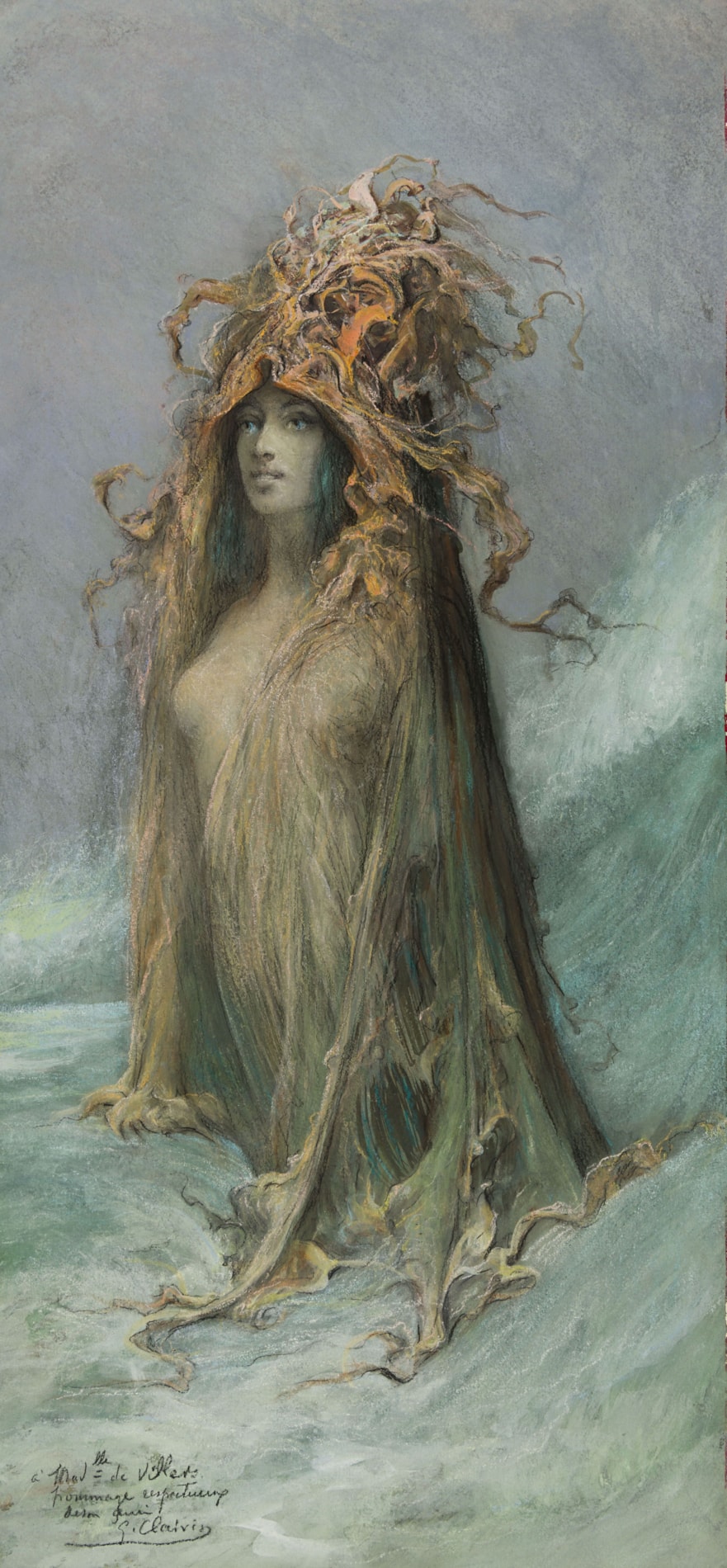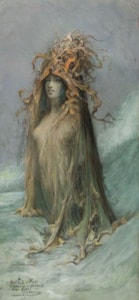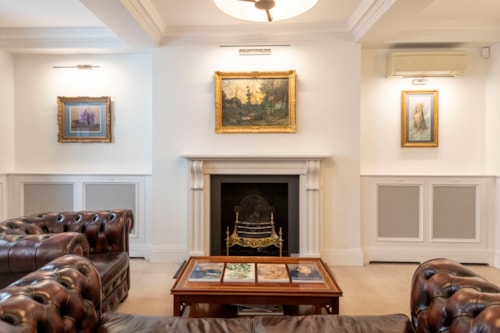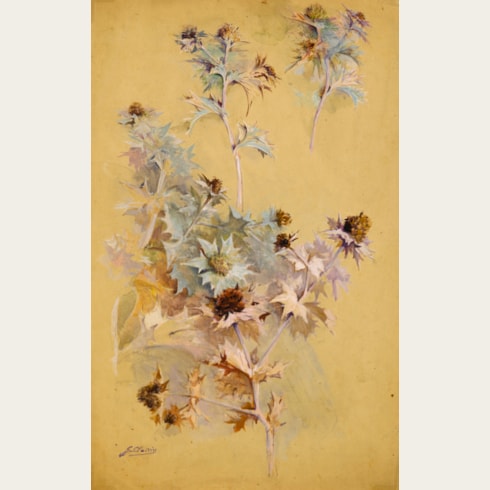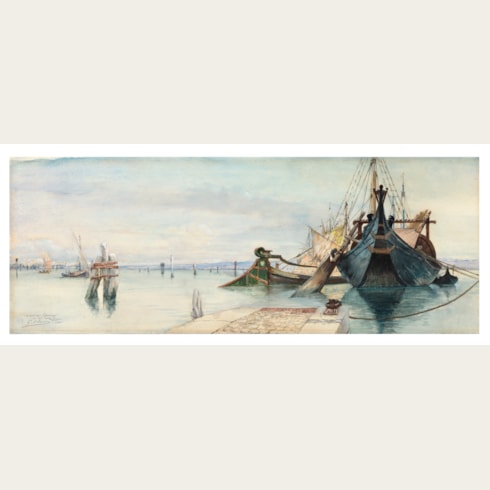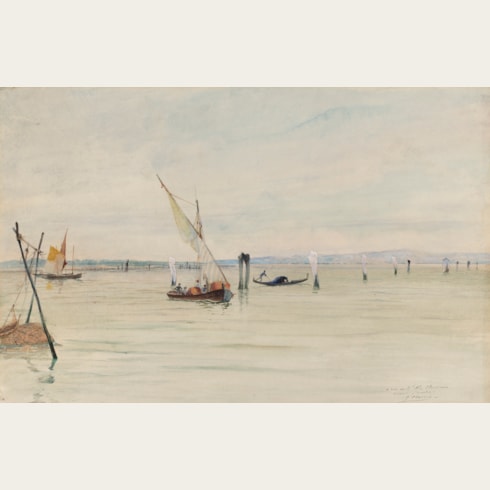Georges CLAIRIN
(Paris 1843 - Belle-Île-en-Mer 1919)
Claudea Flegans: An Allegory of the Sea
Pastel, watercolour and gouache on board.
Signed and dedicated à Madlle de Villers / hommage respectueux / de son ami / G. Clairin at the lower left.
519 x 247 mm. (20 3/8 x 9 3/4 in.) [sheet]
Signed and dedicated à Madlle de Villers / hommage respectueux / de son ami / G. Clairin at the lower left.
519 x 247 mm. (20 3/8 x 9 3/4 in.) [sheet]
Apart from his better-known historical scenes, Orientalist subjects and landscapes, Georges Clairin also produced a small but choice body of work in a more Symbolist vein, often devoted to an exotic theme as represented by an enigmatic female figure. As has been noted of the artist, ‘sometimes going beyond the deserts and the ocean, further than anything reality offered his gaze, he scaled the infinite, he threw himself into a pure dream and he anchored on the canvas adorable visions of women which satisfied his thirst for colour; these are figures of enchantresses, living flowers, possessing an original capriciousness, in a languid pose, an unexpected event where the painter found the perfect opportunity for an innovative effort of decoration.’ Often associated with a marine motif in Clairin’s personal mythology, women were a constant source of inspiration for the painter, while the theme of the sea, and in particular the wave, was a popular subject among Symbolist artists of the 19th century in France.
Traditionally entitled Claudea Flegans, this large and striking drawing, executed in a combination of watercolour, gouache and pastel, presents an allegorical depiction of the seaweed which ensured the safety of sailors and seamen, and is also symbolic of the rich bounty of the sea.
A similar subject appears in Clairin’s well-known painting La Grande Vague (The Great Wave), painted in 1898 and exhibited at the Salon des Artistes Français the same year and at the Exposition Universelle of 1900. A finished preparatory drawing in watercolour and gouache for La Grande Vague was in a private collection in Paris in 1986, while another study for the painting recently appeared at auction in France; both are similar in spirit to the present sheet. Also akin to this large drawing is a remarkable watercolour and gouache study of a nymph with a coral-like headdress, dated 1899 and dedicated by Clairin to the glass and jewellery designer René Lalique, which was sold at auction in London in 2008, and a related drawing in black and white chalk that appeared at auction in Paris in 2017.
Like many of Georges Clairin’s finished watercolours, this large sheet was almost certainly drawn as an independent work of art. Indeed, many of the artist’s most elaborate drawings and watercolours bear dedications to his friends and were presented to them as gifts, and the present sheet is no exception. The recipient of this drawing may have been Suzanne Bernheim de Villers (1883-1961), who in November 1901 married the art dealer Gaston Bernheim de Villers.
Traditionally entitled Claudea Flegans, this large and striking drawing, executed in a combination of watercolour, gouache and pastel, presents an allegorical depiction of the seaweed which ensured the safety of sailors and seamen, and is also symbolic of the rich bounty of the sea.
A similar subject appears in Clairin’s well-known painting La Grande Vague (The Great Wave), painted in 1898 and exhibited at the Salon des Artistes Français the same year and at the Exposition Universelle of 1900. A finished preparatory drawing in watercolour and gouache for La Grande Vague was in a private collection in Paris in 1986, while another study for the painting recently appeared at auction in France; both are similar in spirit to the present sheet. Also akin to this large drawing is a remarkable watercolour and gouache study of a nymph with a coral-like headdress, dated 1899 and dedicated by Clairin to the glass and jewellery designer René Lalique, which was sold at auction in London in 2008, and a related drawing in black and white chalk that appeared at auction in Paris in 2017.
Like many of Georges Clairin’s finished watercolours, this large sheet was almost certainly drawn as an independent work of art. Indeed, many of the artist’s most elaborate drawings and watercolours bear dedications to his friends and were presented to them as gifts, and the present sheet is no exception. The recipient of this drawing may have been Suzanne Bernheim de Villers (1883-1961), who in November 1901 married the art dealer Gaston Bernheim de Villers.
In 1861 Georges-Jules-Victor Clairin entered the Ecole des Beaux-Arts in Paris, where he studied under Isidore Pils and François-Edouard Picot. He first exhibited his work in 1866, and continued to do so throughout his career, winning a silver medal at the Exposition Universelle in 1889. In 1868 Clairin accompanied the painter Henri Regnault on a trip through Spain and Morocco, where he was particularly taken with Moorish architecture and costumes, and he also travelled in Italy in the company of Jean-Léon Gerôme. In Morocco he met the Spanish painter Mariano Fortuny, and together the two artists visited Tetuan. Apart from the easel pictures and illustrations for which he was highly regarded, Clairin received a number of public commissions, notably the ceiling painting for the foyer of the Opéra in Paris, painted in 1874, as well as the Bourse de Commerce, the Sorbonne and the Hôtel de Ville. This was the first of several decorations that Clairin would produce for hotels, chateaux and theatres over the course of his career. In 1895 he travelled to Egypt with the composer Camille Saint-Saëns, although he was taken ill and was unable to cross the Sinai desert as he had wished.
Known to his friends by the nickname ‘Jojotte’, Clairin was a popular member of artistic society in Belle Epoque Paris, and was associated with an elegant crowd of socialites, writers, actors, artists and musicians. He was best known for his numerous paintings of the actress Sarah Bernhardt, who was a close friend and often hosted the artist at her country home. Bernhardt regarded the artist as her preferred painter, and he depicted her in a number of her stage roles as well as in more informal surroundings; two of the finest of his portraits of the actress are today in the Musée des Beaux-Arts in Tourcoing and the Musée du Petit Palais in Paris. Clairin exhibited at the Salon des Artistes Français, the Salon des Peintres Orientalistes Français and the Societé Coloniale des Artistes Français, as well as at the Salon des Artistes Algériens et Orientalistes in Algiers. He was made a Chevalier of the Légion d’Honneur in 1897, four years before a major exhibition of his work was held at the Galerie Georges Petit in Paris. A large number of paintings, watercolours and drawings by the artist were dispersed in two sales of the contents of his studio in Paris in 1920.
Provenance
Given by the artist to a Mademoiselle de Villers (according to the dedication at the lower left), possibly Suzanne Jacobina Bernheim de Villers, Paris
Galerie Tanagra, Paris, in 1974
Galerie Mona, Paris, in 1986
Private collection, Paris
Galerie Coligny, Paris, in 1993;
Private collection, Paris.
Galerie Tanagra, Paris, in 1974
Galerie Mona, Paris, in 1986
Private collection, Paris
Galerie Coligny, Paris, in 1993;
Private collection, Paris.
Literature
‘Selection: A selection from some of the fine works of art and antiques on the international market’, The Connoisseur, April 1975, p.306, fig.1; Delphine Montalant and Ian Millman, ed., Le Symbolisme et la femme, exhibition catalogue, Paris, Toulon, Pau and Marcq-en-Barœul, 1986, p.61, no.8 (entry by Françoise Hugont); André Cariou, L’or brun des faucheurs de la mer, Spézet, 2023, illustrated p.76.
Exhibition
Paris, Galerie Tanagra, Les Perfectionnistes 1843-1917: Peintres du réel et de l’imaginaire, 1974-1975, no.1; Paris, Mairie du 9e arrondissement (Délégation à l’action artistique de la Ville de Paris), and elsewhere, Le Symbolisme et la femme, 1986, no.8; Tokyo, Isetan Museum of Art, and elsewhere, Terres d’inspiration des peintres de Pont-Aven, Nabis et Symbolistes, 1987, no.126; Paris, Galerie Coligny, Rêveries, Symbolisme et Croix-Rose, 1993 [number unknown]; Paris, Petit Palais, Musée des Beaux-Arts de la Ville de Paris, Sarah Bernhardt: Et la femme créa la star, 2023.

